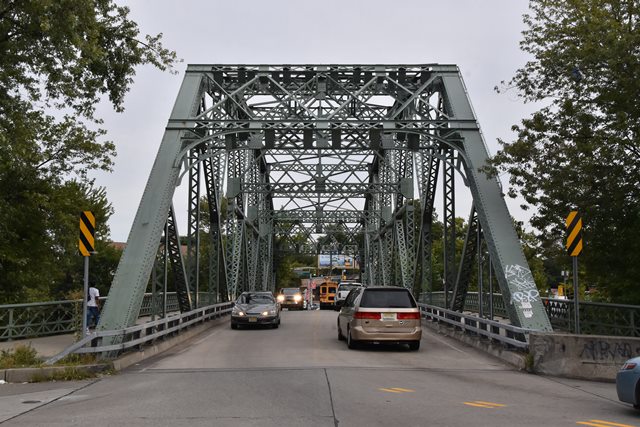We Recommend:
Bach Steel - Experts at historic truss bridge restoration.
Straight Street Bridge

Primary Photographer(s): Nathan Holth
Bridge Documented: September 5, 2019
Paterson: Passaic County, New Jersey: United States
1907 By Builder/Contractor: Unknown and Engineer/Design: Colin R. Wise
2003
251.0 Feet (76.5 Meters)
255.0 Feet (77.7 Meters)
27 Feet (8.23 Meters)
1 Main Span(s)
1600014

View Information About HSR Ratings
Bridge Documentation
This bridge is noted as an early rivet-connected Pennsylvania through truss highway bridge. Pennsylvania truss bridges are uncommon, and most bridges built around the time this bridge was built were still using pin connections. Thus this county-designed bridge would have been cutting-edge engineering, something the county would have been proud to design in-house.
View Archived National Bridge Inventory Report - Has Additional Details and Evaluation
Information and Findings From New Jersey's Historic Bridge InventorySummary The heavy rivet-connected 6-panel Pennsylvania thru truss bridge with cantilevered sidewalks is supported on ashlar abutments from a previous span lost in the 1903 flood. In addition to being a rare example of the truss type applied to vehicular use, the 1907 bridge is well preserved with alterations apparently limited to the flooring system. The bridge is technologically significant because of its type and state of preservation. Setting/Context The bridge carries two lanes of traffic and two sidewalks over the Passaic River in an a mixed use area of commercial, industrial, and residential structures near downtown Paterson. The buildings date from the late-19th and early-20th centuries. Physical Description DESIGNER/PATENT COLIN R. WISE, CO. ENGINEER. The 6-panel Pennsylvania thru truss bridge of riveted construction is supported on brownstone ashlar abutments from a previous superstructure. The span is 255' long and 30.7' wide, and it survives in virtually unaltered condition. It is composed of traditionally built-up box members for the top and bottom chords and inclined end posts while the diagonals, verticals and sub ties and sub struts of the center subdivided panels are either laced channels or angles. While displaying no unusual construction details, the span is a good representative example of its type. The cantilevered sidewalks are enclosed by lattice-pattern railings that extend beyond the superstructure and also enclose the approaches. Historical and Technological Significance The 1907 riveted Pennsylvania thru truss bridge is historically and technologically significant as a well-preserved example of an uncommon truss type (criterion C). The Pennsylvania truss, a Parker variation on the Pratt truss with sub ties (tension) and sub diagonals (compression), or subdivided panels, was devised by Albert Fink in the late 1860s for the Pennsylvania Railroad's bridge across the Ohio River at Louisville. The engineers at the Pennsylvania Railroad immediately saw the merit of Fink's design, and they worked to simplify his design by reducing the number of intermediate members in each subdivided panel. By 1875, Fink's design had been developed in the Pennsylvania, or Petit, truss type represented by the Straight Street bridge. The polygonal top chord allowed for strength in the trusses where they are most needed balanced with economy of material, and it became a standard detail for long-span metal truss bridges after about 1875. The addition of a subdivision to center panels of Pratt trusses grew out of a recognition of the stress reversal from live loads through the length of the trusses. The Straight Street bridge is one of the few Pennsylvania truss highway bridges in the state. The truss type is more commonly associated with railroads. The earlier span at this crossing was lost in the October, 1903 flood that carried away most of the bridges in the center of Paterson. A temporary wooden bridge was built at the crossing. The Pennsylvania thru truss replacement, not completed until 1907, was designed by then county engineer Colin R. Wise. Because of its location in what was then an industrial area of Paterson, the bridge was designed for heavy live load capacity. The bridge type is thus reflective of the historical development and use of the surrounding area. Unfortunately, much of the historic context of the span has been lost through modern urban renewal program redevelopment. Boundary Description and Justification The historic context of the bridge has been lost due to demolition of some of the historic factories and housing that surrounded it. The area does not have historic district potential. The bridge is evaluated as individually significant, and the boundaries are limited to the span itself, the superstructure and the substructure including the wingwalls. Sources Passaic County Engineer. Bridge File 14. Condit, Carl. American Building Art The 19th and 20th Century. New York, 1960. Minutes. Passaic County Board of Chosen Freeholders. October 15, 1903. Bridge Considered Historic By Survey: Yes |
![]()
Photo Galleries and Videos: Straight Street Bridge
Bridge Photo-Documentation
Original / Full Size PhotosA collection of overview and detail photos. This gallery offers photos in the highest available resolution and file size in a touch-friendly popup viewer.
Alternatively, Browse Without Using Viewer
![]()
Bridge Photo-Documentation
Mobile Optimized PhotosA collection of overview and detail photos. This gallery features data-friendly, fast-loading photos in a touch-friendly popup viewer.
Alternatively, Browse Without Using Viewer
![]()
Maps and Links: Straight Street Bridge
Coordinates (Latitude, Longitude):
Search For Additional Bridge Listings:
Bridgehunter.com: View listed bridges within 0.5 miles (0.8 kilometers) of this bridge.
Bridgehunter.com: View listed bridges within 10 miles (16 kilometers) of this bridge.
Additional Maps:
Google Streetview (If Available)
GeoHack (Additional Links and Coordinates)
Apple Maps (Via DuckDuckGo Search)
Apple Maps (Apple devices only)
Android: Open Location In Your Map or GPS App
Flickr Gallery (Find Nearby Photos)
Wikimedia Commons (Find Nearby Photos)
Directions Via Sygic For Android
Directions Via Sygic For iOS and Android Dolphin Browser
USGS National Map (United States Only)
Historical USGS Topo Maps (United States Only)
Historic Aerials (United States Only)
CalTopo Maps (United States Only)

